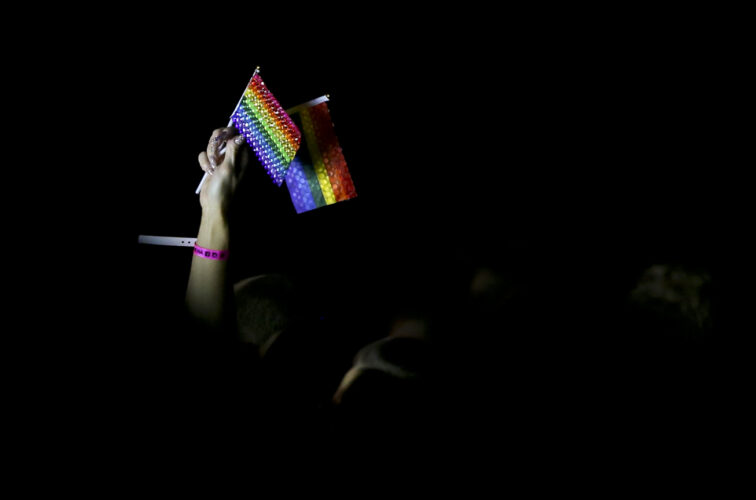Guest: Acceptance key for reducing suicide among LGBTQ+ in Utah

Isaac Hale, Daily Herald file photo
A fan holds pride flags as Sam Smith performs during his "The Thrill of It All Tour" held Wednesday, Aug. 22, 2018, at Vivint Smart Home Arena in Salt Lake City.According to the Utah Department of Health, Utah has one of the highest suicide rates in the nation. It is the sixth-leading cause of death among adults, as well as the leading cause of death among youth ages 10-17. The risk of suicide is even greater among Utah’s LGBTQ+ population.
A 2020 study conducted by McGraw, Peer, McManimen, Chinn and Mahoney found a significant difference in suicidal ideation and suicide attempts between heterosexual and non-heterosexual Utah residents. The rate of suicidal ideation among heterosexuals was 3.5%, while the rate among sexual minorities was 14.7%. Correspondingly, the lifetime prevalence of one or more suicide attempts among heterosexuals was found to be 5.8%, while the rate among sexual minorities was 37.2%. In essence, lifetime suicide attempts among sexual minorities are six times more likely, which, according to the American Academy of Pediatrics, surpasses the national average wherein sexual minorities are only three times as likely to attempt suicide.
Why are suicide rates for sexual minorities so high in Utah? According to the Utah Suicide Prevention Coalition, rejection plays a major role in suicide rates among LGBTQ+ teens. Those experiencing rejection from caregivers are more than eight times as likely to attempt suicide than those who experience little to no rejection. In seeking to identify what might make Utah unique in terms of attitude toward sexual minorities, many point towards Utah’s most unique demographic — religious identification. According to the World Population Review, approximately 68% of Utahns identify as members of The Church of Jesus Christ of Latter-day Saints. While identifying with the LDS faith does not necessarily require a rejection of sexual minorities, the LDS Church has demonstrated a historically tense relationship with sexual minorities. This is evidenced by a series of policies that prohibit sexual minorities — and occasionally those associated with them — from engaging in the full range of activities associated with church membership. For instance, it was only as of April 4, 2019, that the church announced that it would no longer consider same-sex marriage as apostasy and that children of LGBTQ+ parents may be baptized.
While Elder Dallin H. Oaks of the First Presidency of the church stated that these changes were established with the intent to increase compassion and reduce contention, he persisted to reiterate that same-sex marriage is “still considered a serious transgression.” This policy change may be an improvement from outright condemnation of LGBTQ+ individuals, yet it remains a far cry from acceptance. Elder Jeffrey R. Holland, a high-profile member of the church and a former president of Brigham Young University, spoke out in August about the difficult relationship between BYU (a church-sponsored institution) and same-sex relationships. He described symbols of same-sex love as “divisive”, “a slippery slope”, and “a threat to the unity” of the church. Like Oaks, he explained that his argument was based in compassion, yet was careful to reinforce that compassion does not negate the church’s disavowal of same-sex relationships. In a state where there is such conflict over the very concept of queerness, how do we protect LGBTQ+ individuals?
Protective factors such as affirming communities, inclusive curriculum in schools, and access to mental health services should be adopted across the state. Creating safe spaces in schools and promoting positive LGBTQ+ messages is one of the most effective ways to support LGBTQ+ youth. According to a 2021 research brief by The Trevor Project, “LGBTQ+ youth in affirming schools had nearly a 40% lower chance of attempting suicide compared to LGBTQ+ youth in non-affirming schools.” The importance of acceptance and belonging is detailed in a study by Toomey, Ryan, Diaz and Russell in 2012 that showed that schools with a gay-straight alliance club exhibited better treatment of LGBTQ+ youth and greater school connectedness and safety. It should be a priority in other youth settings, such as extracurricular groups, health institutions, and churches to create a greater sense of belonging for LGBTQ+ kids. Adults should also ensure that youth have access to affirming mental health services, but in instances where this is not the case, LGBTQ+ youth can receive 24/7 counselor support through the Trevor Project.
To help Utah become a safer place for LGBTQ+ youth: write to the state school board to include positive messages about the LGBTQ+ community in the school curriculum and to adopt Safe Schools Initiatives (just like New Mexico schools in 2019), and vote for board members who will be LGBTQ+ advocates. Volunteer in your community at organizations such as Encircle, or donate to the Utah Pride Center. Lastly, inspire change within your church community through meaningful dialogue or wearing a pride pin at gatherings. No matter your faith, supporting LGBTQ+ youth is supporting life.
Bekah Wrigley, Jessica Roundy and Bre Caso are graduate students in social work at the University of Utah.


